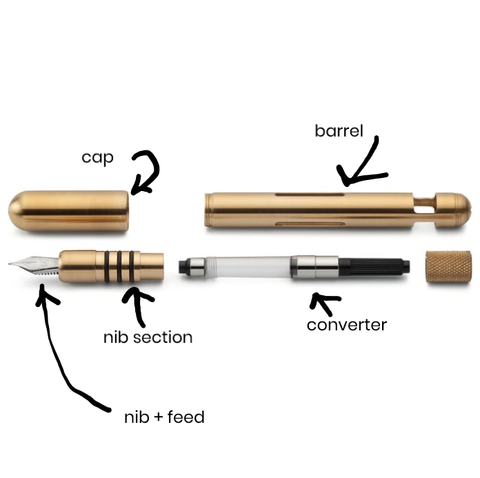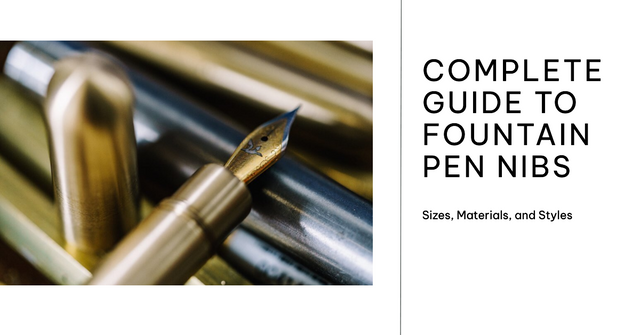Key Takeaways
-
Fountain Pen Structure: Understand the key parts of a fountain pen, including the nib, barrel, cap, and ink reservoir.
-
Types of Fountain Pens: Explore cartridge pens, converter pens, piston pens, and eyedropper pens, each with a unique filling mechanism.
-
Choosing the Right Fountain Pen: Consider size, weight, and filling mechanism when selecting a pen that suits your preferences.
-
Importance of High-Quality Paper: Opt for quality paper to enhance your writing experience and prevent ink bleeding.
-
Preparing Your Fountain Pen: Learn how to fill the ink correctly and test the ink flow before writing.
-
Proper Grip and Posture: Use the tripod grip, position your arm correctly, and maintain the appropriate pen angle for smooth writing.
-
Writing Techniques: Follow techniques like writing under the line, keeping your hand rigid, and applying minimal pressure.
-
Fountain Pen Care: Clean your pen regularly, store it properly, and avoid pressing too hard or using poor quality paper.
Importance of Writing with a Fountain Pen
In today's digital age, the art of handwriting has become somewhat of a lost art.
However, there is a certain charm and personal touch that comes with writing by hand, especially when using a fountain pen.
Fountain pens offer a unique writing experience, providing smooth ink flow and a wide range of line variations.
They are not just writing instruments but a symbol of sophistication, personal expression, and respect for traditional craftsmanship.
Brief History of Fountain Pens
The fountain pen has a rich history dating back to the 10th century.
The modern version of the fountain pen, with an ink reservoir and a capillary feed, was developed in the 19th century.
Over the years, fountain pens have been refined and improved, but they still maintain their classic appeal and functionality.
They have been used to sign important documents, write literary masterpieces, and even as a status symbol.
Today, they are cherished by calligraphers, writers, and anyone who appreciates the art of writing.
In the next sections, we will delve into the world of fountain pens, exploring their parts, how to choose the right one, and how to write with them.
If you're interested in owning a piece of this timeless tool, check out our collection of high-quality fountain pens here.
Understanding the Fountain Pen
Before we delve into the art of writing with a fountain pen, it's important to understand its structure and the different types available.
Parts of a Fountain Pen
A fountain pen is more than just a writing instrument; it's a piece of intricate craftsmanship.
Here are the main parts:
- Nib: This is the part that touches the paper. It's usually made of gold, steel, or other metals and is responsible for the distribution of ink on the paper.
- Barrel: This is the long part of the pen that you hold. It houses the ink reservoir and connects to the nib.
- Cap: The cap protects the nib when the pen is not in use. Some caps are screw-on, while others are snap-on.
- Ink Reservoir: This is where the ink is stored. The size of the reservoir determines how much ink the pen can hold.

Image: Loclen Electa fountain pen
Different Types of Fountain Pens
There are several types of fountain pens, each with its unique filling mechanism:
- Cartridge Pens: These pens use disposable ink cartridges. They are convenient and easy to use.
- Converter Pens: These pens use a removable filling system (the converter) that allows you to use bottled ink.
- Piston Pens: These pens have a built-in piston filling system. You turn a knob to draw ink into the pen.
- Eyedropper Pens: These pens are filled by using an eyedropper to transfer ink directly into the barrel.
Understanding these parts and types will help you choose the right fountain pen for your needs.
While most of our pens are versatile, as they come with a standard converter but also allow the use of the cartridges, Tiny is a pen that can only be refilled using cartridges.
Choosing the Right Fountain Pen
Choosing the right fountain pen is a personal journey, as the perfect pen varies from person to person.
Here are some factors to consider:
Factors to Consider
- Size: The size of the pen can affect your writing comfort. If you have larger hands, you might prefer a larger pen, while those with smaller hands might prefer a smaller one.
- Weight: The weight of the pen can also impact your writing experience. Some people prefer heavier pens for their perceived durability and luxury, while others prefer lighter pens for their ease of use.
- Filling Mechanism: As mentioned earlier, there are different types of fountain pens based on their filling mechanism: cartridge, converter, piston, and eyedropper. Your choice depends on your preference for convenience versus capacity.

Evolution is a perfect choice for those seeking their first fountain pen.
Its compact and portable design makes it convenient for on-the-go use, while the high-quality nib ensures consistent ink flow.
Ideal for beginners, this fountain pen combines affordability, durability, and elegance, making it an excellent entry-level option.
Importance of Using High-Quality Paper
The paper you use with your fountain pen is just as important as the pen itself.
High-quality paper provides a smoother writing experience and reduces the chance of ink bleeding or feathering.
It also showcases the unique ink flow and line variation of fountain pens.
Choosing the right fountain pen and paper can significantly enhance your writing experience.
Preparing Your Fountain Pen for Writing
Before you start writing with your fountain pen, there are a couple of steps you need to take to prepare it.
Filling the Ink
The process of filling the ink depends on the type of fountain pen you have.
For cartridge pens, you simply insert a new cartridge.
For converter, piston, and eyedropper pens, you'll need to draw ink from a bottle.
Always ensure you're using the right type of ink for your pen.
If you wish to know more about different types of fountain pen ink and how to choose the right one, you can check out our guide here.
Testing the Flow of Ink
After filling the pen, test the flow of ink on a scrap piece of paper.
The ink should flow smoothly without skipping or blotching.
If the ink flow is inconsistent, your pen might need cleaning.
Proper Grip and Posture
Writing with a fountain pen requires a different grip and posture compared to regular pens.
The Tripod Grip
The tripod grip is the recommended grip for fountain pens.
Hold the pen between your thumb and index finger, resting it on your middle finger.
This grip provides control and stability.
Positioning of the Arm and Shoulder
Unlike ballpoint pens, writing with a fountain pen involves more of your arm and shoulder.
Keep your wrist relaxed and let your arm guide the movement.
Angle of the Pen
The angle of the pen to the paper is crucial.
Ideally, the pen should make a 40 to 55-degree angle with your paper.
This angle allows the nib to glide smoothly across the paper, reducing the risk of scratching or digging into the paper.
Now that your pen is ready and you're holding it correctly, you're all set to experience the joy of writing with a fountain pen.
Writing Techniques
Writing with a fountain pen is a unique experience that requires a few specific techniques to get the best results.
Writing with Your Hand Under the Writing Line
Unlike writing with a ballpoint or rollerball pen, when writing with a fountain pen, your hand should be under the writing line.
This position allows the nib to make proper contact with the paper, ensuring a smooth ink flow and preventing any scratching or skipping.
Keeping Your Hand Rigid
While your arm and shoulder should be relaxed, your hand should remain relatively rigid.
This rigidity provides the necessary control and stability when writing with a fountain pen.
Remember, the movement should come from your arm and shoulder, not your wrist.
Applying the Right Pressure
One of the beauties of a fountain pen is that it requires very little pressure to write.
Unlike ballpoint pens, which require you to press down, a fountain pen should glide across the paper with minimal pressure.
Applying too much pressure can damage the nib and disrupt the ink flow.
Mastering these techniques will enhance your writing experience and help you fully appreciate the art of writing with a fountain pen.
Fountain Pen Care and Maintenance
Maintaining your fountain pen is crucial to ensure its longevity and optimal performance.
Cleaning Your Fountain Pen Regularly
Regular cleaning prevents ink from drying out and clogging the nib.
Rinse the nib with warm water until the water runs clear, then let it dry completely before refilling with ink.
Keeping It Away from Extreme Temperatures
Extreme temperatures can cause the ink to leak or the pen parts to warp.
Store your pen in a cool, dry place.
Storing Your Fountain Pen Properly
When not in use, store your pen upright with the nib facing up to prevent ink from drying in the nib.
Common Mistakes to Avoid
While fountain pens are a joy to write with, there are a few common mistakes to avoid.
- Pressing Too Hard: Unlike ballpoint pens, fountain pens require minimal pressure. Pressing too hard can damage the nib and disrupt the ink flow.
- Using Poor Quality Paper: High-quality paper enhances the writing experience by reducing ink bleeding and feathering.
- Neglecting Regular Cleaning: Regular cleaning keeps your pen in optimal condition and extends its lifespan.
Frequently Asked Questions (FAQ)
Is there a trick to writing with a fountain pen?
Can fountain pens be used daily?
Do fountain pens write better over time?
Do you have to write slower with a fountain pen?
Why do people still write with fountain pens?
Conclusion
Writing with a fountain pen is a unique and rewarding experience.
It's not just about putting words on paper; it's about appreciating the art of writing.
Remember to choose the right pen, hold it correctly, use the right techniques, and take good care of it.
With practice and exploration, you'll soon discover the joy of writing with a fountain pen.
Check out our collection of fountain pens and start your journey today!
More Resources
- Blog featured image di Eugene Chystiakov su Unsplash
- How to Choose the Perfect Fountain Pen Ink
Find similar articles:
Fountain Pen
